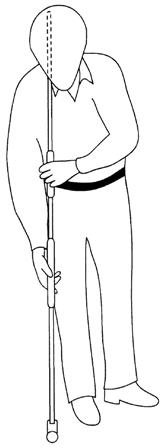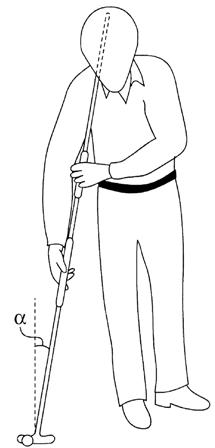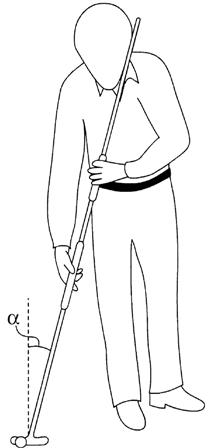Day 1 – Patented Putting Strokes; Simply Put a Little Shoulder Into Your Stroke
In the past I have covered a few patented putting methods/strokes (here, here, here, and here) and these seem to be popular posts among the readers. Therefore I have decided to make a week of it. The first method of putting patent for the week is USPN 6,595,867, which claims:
1. A method of putting, comprising: addressing a golf ball in a sidesaddle stance; swinging a puffer having an elongated shaft; controlling the putter during the putting swing from at least three points of contact, wherein said at least three points of contact comprises; the contact points of both hands, and the contact point of the shaft on a golfer’s shoulder.
This method gives new meaning to the term “long putter.”



The patent goes on to explain:
In an alternative embodiment, as shown in FIGS. 6C-6E, the shaft can extend beyond the shoulder of the golfer, perhaps by 3 to 12 inches. This would allow the golfer to rest the shaft against his shoulder and achieve greater stability of the putter and a better putting stroke. The stability arises because there are three points of control: each hand and the point where the shaft rests on the shoulder. A better putting stroke arises because if the hands operate such that the shaft continues to touch the shoulder at the designated point throughout the stroke, it is been found to be virtually impossible to bend or “breakdown” the wrists. Breakdown of the wrists results in an inconsistent putting stroke and can also be a source of the “yips”–a sudden and seemingly uncontrolled lunging at the ball with the putter. A putter according to the invention helps achieve a truer pendulum stroke and eliminates or ameliorates the problem of wrist breakdown and yips.
.
.
.
FIG. 6E illustrates an alternative embodiment for the use of the invention in which the point of shoulder contact and the extension of the elongated shaft occurs at the golfer’s shoulder farthest from the golf ball during a putting swing, as opposed to the shoulder nearest to the golf ball. A golfer is free to determine which shoulder is most suited for any particular putt. This embodiment is equally applicable to toe-putting or conventional putting with the traditional face of the putter. In a preferred embodiment, the angle a shown in FIG. 6E can be between 10 and 45 degrees.
.
.
.
A putter according to the invention may have two grips, as can be seen in FIGS. 6B-6E. In addition, I have found that a wider than normal grip limits the use of the small muscles of the hand while putting, and thus may make it easier for the golfer to maintain a consistent putting technique. Putters according to the invention thus may have grip diameters of 1-11/2 inches or more.
OK, so where can I get a putter shaft that is six feet long? I wonder which Tour player would be first to give this method a try.
Dave Dawsey – Monitoring Patented Putting Strokes
